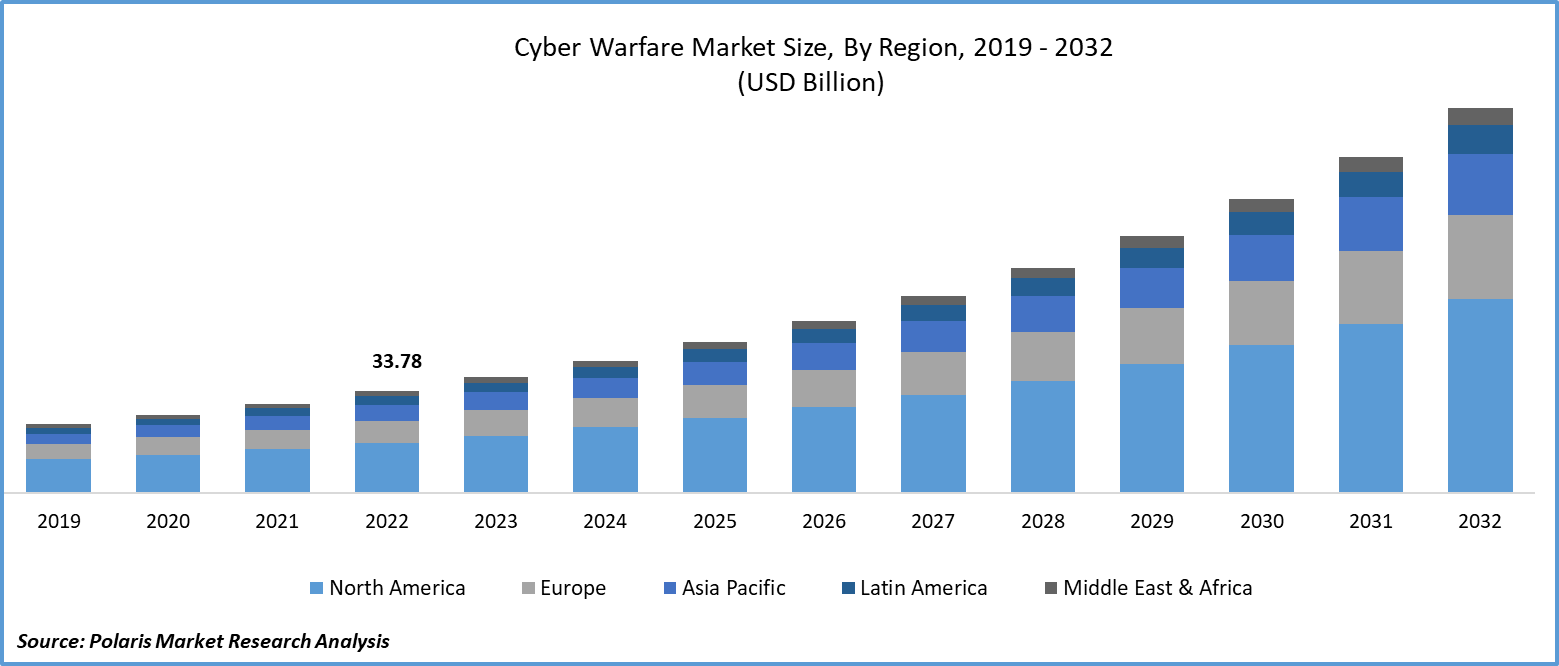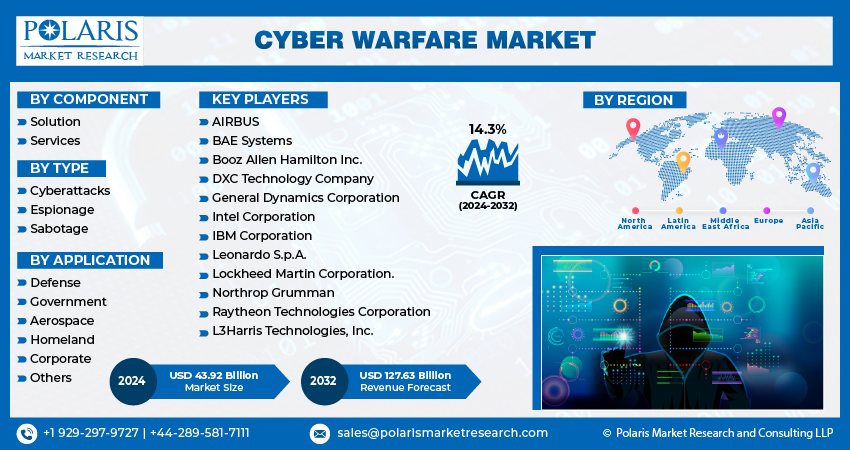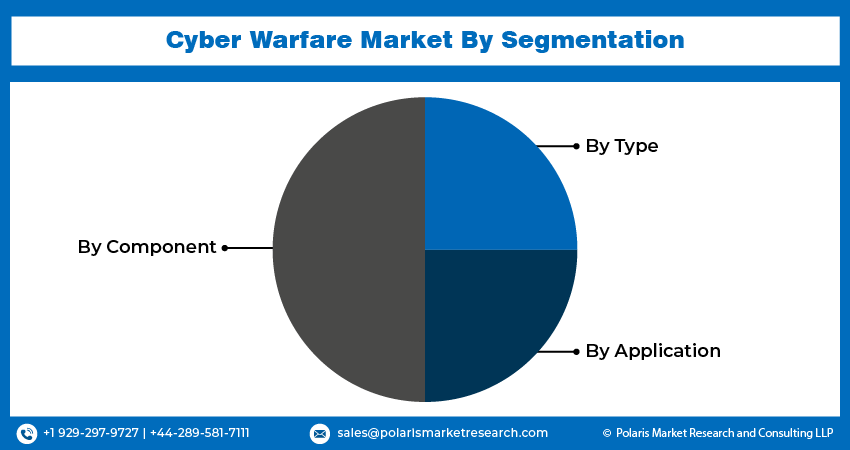
Cyber Warfare Market Share, Size, Trends, Industry Analysis Report, By Component; By Type; By Application (Defense, Government, Aerospace, Homeland, Corporate); By Region, And Segment Forecasts, 2024 - 2032
- Published Date:Jan-2024
- Pages: 114
- Format: PDF
- Report ID: PM4005
- Base Year: 2023
- Historical Data: 2019-2022
Report Outlook
The global cyber warfare market was valued at USD 38.51 billion in 2023 and is expected to grow at a CAGR of 14.3% during the forecast period.
Governments and international organizations are increasingly prioritizing cybersecurity due to the rising security threats emerging from cyberspace. These challenges have sparked significant concerns about national security, underscoring the urgent need for a strong cybersecurity framework. As a result, government entities, military forces, and various agencies are taking extensive measures to safeguard their digital infrastructure and internet-connected devices in order to prevent potential cyber-attacks.

To Understand More About this Research: Request a Free Sample Report
The process of digitization has gained momentum in emerging nations. However, it has also led to an increase in cyber warfare, which poses a significant challenge to their growth. In response, several countries have invested in cybersecurity, creating dedicated units to combat cyber espionage and data breaches, especially in the military and defense sectors. This growing demand for cybersecurity is expected to drive the cyber warfare market in the near future.
The U.S. Federal Government has taken on various initiatives to counter cyber-attacks and consistently showcases its capabilities in cyber warfare to deter potential adversaries from sophisticated attacks. The government is actively strengthening its cyber capabilities by planning to establish 133 teams for its "cyber mission force" between 2018 and 2027.
Additionally, it is engaged in proactive training and development programs for military personnel through institutions like the U.S. Army Cyber Center of Excellence (CCoE), which focuses on cyberspace operations, signal/communications networks, and information services. Furthermore, the increased defense budget allocated to safeguard cyberspace protect Federal networks, and critical infrastructure from cyber-attacks is expected to drive market growth in the foreseeable future.

Industry Dynamics
Growth Drivers
- The increasing significance of cyber warfare in global defense and security
The adoption of cyber warfare systems worldwide is expected to be primarily driven by the rise in defense expenditure aimed at enhancing government efficiency and cybersecurity capabilities. The market growth is also anticipated to be propelled by agendas that focus on government IT infrastructure modernization, facility upgrades, and addressing cybersecurity vulnerabilities in the coming years.
The global threat landscape is being reshaped by continuous progress in IT technology and the increasing capabilities of cyber weapons, which pose a significant threat to national security. Cyber-related threats are now recognized as some of the most prevalent risks worldwide. Cyber warfare has emerged as a substantial threat to nations, surpassing even terrorism in its significance. Reducing losses caused by rising cyber-attacks, which often lead to economic disruptions in countries, has become a major concern.
Report Segmentation
The market is primarily segmented based on component, type, application, and region.
|
By Component |
By Type |
By Application |
By Region |
|
|
|
|
To Understand the Scope of this Report: Speak to Analyst
By Application Analysis
- Defense segment accounted for the largest share of the market in 2022
The defense segment held the largest share. The military and defense industry's heavy reliance on communication and information technology has made it susceptible to cyber risks. Recognizing this vulnerability, the defense sector has increased its funding for cybersecurity units to counter and deter potential threats posed by national and state hackers.
The introduction of new technologies and the integration of the Internet of Things (IoT) in defense operations are pivotal factors driving the adoption of cyber warfare systems in the defense sector. These advancements not only enhance the efficiency of military operations but also introduce new avenues for cyber threats. As a result, there is a pressing need to implement robust cybersecurity measures, including cyber warfare systems, to safeguard sensitive military data, critical infrastructure, and communication networks from cyber-attacks.
Additionally, the ongoing development of existing cybersecurity technologies and posture is anticipated to boost further the application of cyber warfare systems in the defense sector. As cyber threats continue to evolve, the defense industry is actively striving to stay ahead by investing in innovative solutions and strategies to protect national security interests. Consequently, the integration of advanced cyber warfare systems becomes crucial in ensuring the defense sector's resilience against ever-changing and sophisticated cyber threats.
The government segment will grow at a substantial pace. The rise in cyber threats has prompted developed nations to focus on building resilience and implementing comprehensive national cybersecurity strategies. These strategies are multifaceted, involving robust policies, advanced technologies, and stringent regulations aimed at safeguarding government systems, critical infrastructure, and sensitive data from cyber-attacks. Such efforts are vital in ensuring the security and stability of the nation, especially considering the increasing frequency of cyber-attacks, which can have far-reaching consequences on both the public and private sectors.
As the threat landscape continues to evolve, governments are investing significantly in enhancing their cybersecurity capabilities. This includes developing innovative solutions, fostering international collaborations, and promoting cybersecurity education and awareness among citizens and businesses. By adopting these proactive measures, governments aim to mitigate cyber vulnerabilities, strengthen their digital defenses, and ensure the resilience of their critical systems in the face of growing cyber threats.

Regional Insights
- The demand in North America garnered the largest share in 2022
The North America region dominated the global market. There has been a notable increase in the cyber defense budget in the region. The governments in this region are allocating substantial resources to enhance their cyber capabilities, recognizing the critical importance of protecting digital infrastructure from evolving cyber threats. Concerted effort by governments in the region to safeguard their digital assets. These efforts encompass strengthening cybersecurity approaches, implementing advanced technologies, and enforcing stringent regulations to fortify the resilience of digital systems against cyber-attacks.
Additionally, the establishment of specialized cybersecurity units and the deployment of robust cybersecurity frameworks within government agencies, military organizations, and the defense sector are contributing significantly to market growth. These dedicated units and frameworks are essential in mitigating cyber risks, ensuring data security, and defending against potential cyber threats, bolstering the overall cybersecurity posture of the region.
Asia Pacific will grow at a rapid pace throughout the forecast period. The region's rapid growth in the market can be attributed to proactive government initiatives, economic expansion, technological advancements, and the growing necessity to defend against cyber-attacks. These factors collectively create a conducive environment for the adoption and development of cyber warfare applications, leading to the region's remarkable growth in this sector.
Furthermore, the region is experiencing a swift pace of technological advancements in cyberspace. These advancements include innovative cybersecurity tools, threat intelligence systems, and data protection technologies. As the cyber landscape evolves, nations in the Asia Pacific are investing in cutting-edge solutions to stay ahead of potential cyber-attacks and secure their digital domains.
Another crucial factor fueling the market growth in the region is the increasing frequency of cyber-attacks. Governments are recognizing the urgency of bolstering their cyber defenses due to the rising threats. Consequently, these cyber-attacks are influencing defense budget allocations, prompting governments to invest substantially in cyber warfare solutions. This heightened focus on cybersecurity is expected to drive the market in the foreseeable future.

Key Market Players & Competitive Insights
Some of the major players operating in the global market include:
- AIRBUS
- BAE Systems
- Booz Allen Hamilton Inc.
- DXC Technology Company
- General Dynamics Corporation
- Intel Corporation
- IBM Corporation
- Leonardo S.p.A.
- Lockheed Martin Corporation.
- Northrop Grumman
- Raytheon Technologies Corporation
- L3Harris Technologies, Inc.
Recent Developments
- In April 2023, Thales partnered with 11 specialized cybersecurity organizations and companies in France to launch a platform focused on cyber intelligence and threat detection. The aim was to create a unified platform that provides cyber threat intelligence services to both companies and government entities.
- In May 2023, Mosaic joined forces with Safe Security to launch an innovative cyber coverage solution. This collaboration includes incorporating real-time cyber-risk data into Mosaic's underwriting procedure.
- In August 2022, SynSaber successfully raised USD 13 million in a Series A funding round. This funding has been instrumental in further developing SynSaber's industrial asset and network monitoring solution. It has also facilitated the company's global expansion, supported sales, marketing, and development initiatives, and bolstered customer engagement as well as industry research endeavors.
Cyber Warfare Market Report Scope
|
Report Attributes |
Details |
|
Market size value in 2024 |
USD 43.92 billion |
|
Revenue forecast in 2032 |
USD 127.63 billion |
|
CAGR |
14.3% from 2024 – 2032 |
|
Base year |
2023 |
|
Historical data |
2019 – 2022 |
|
Forecast period |
2024 – 2032 |
|
Quantitative units |
Revenue in USD billion and CAGR from 2024 to 2032 |
|
Segments covered |
By Component, By Type, By Application, By Region |
|
Regional scope |
North America, Europe, Asia Pacific, Latin America; Middle East & Africa |
|
Customization |
Report customization as per your requirements with respect to countries, region and segmentation. |
Gain profound insights into the 2024 Cyber Warfare Market with meticulously compiled statistics on market share, size, and revenue growth rate by Polaris Market Research Industry Reports. This thorough analysis not only provides a glimpse into historical trends but also unfolds a roadmap with a market forecast extending to 2032. Immerse yourself in the comprehensive nature of this industry analysis through a complimentary PDF download of the sample report.
